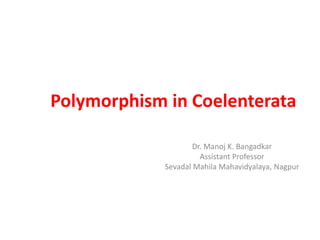
Polymorphism in coelenterata
- 1. Polymorphism in Coelenterata Dr. Manoj K. Bangadkar Assistant Professor Sevadal Mahila Mahavidyalaya, Nagpur
- 2. • The occurrence of more than one type of structurally and functionally different individuals within a population is called polymorphism. • The class Hydrozoa of phylum Coelenterata includes a large number of colonial species that contain more than one form of individuals which are called zooids Coelenterates have two basic zooids, polyp and medusa. • All other types of zooids are modifications of these two types of zooids.
- 3. • Polyp has a tubular body with a mouth surrounded by tentacles at one end. Other end is blind and usually attached by a pedal disc to the substratum. Polyps are concerned with feeding, protection and asexual reproduction. • Medusa has a bowl or umbrella shaped body with marginal tentacles and mouth is centrally located in a projection called manubrium on the ventral concave surface. Medusae are generally motile and concerned with sexual reproduction.
- 4. Modifications of Polyp • Gastrozooids or feeding zooids are typical polyps with a mouth and surrounding tentacles. • Dactylozooids which are used for defence are polyps without mouth and usually with a long basal tentacle. • Gonozooids are reproductive zooids derived from polyp, which produce sexual medusae or gonophores.
- 5. Modifications of Medusa Nectophore or nectocalyx or swimming bell is a medusa modified for sexual reproduction. Pneumatophore or float is a bladder-like modified medusa filled with mixture of gases and helping the colony to float on the surface. Phyllozooids are leaf like Bract, studded with nematocysts and serving to protect the colony. Gonophores bears gonads, dioecious and produce germ cells for reproduction.
- 6. TYPES OF POLYMORPHISM A few coelenterates, such as Hydra and sea anemone are monomorphic in which only polyp stage is found but other coelenterates exhibit polymorphism. Dimorphism: Many hydrozoan colonies like Tubularia and Campanularia have only two types of zooids, the feeding zooids or gastrozooids and medusae or nectophores that bud off from the stem or gastrozooids. Trimorphism: Some species like Obelia and Plumularia are trimorphic because besides gastrozooids and medusa, they also have medusa-producing gonozooids or blastostyle.
- 7. Polymorphism: In order Siphonophora, such as Diphyes, Halistemmia, Stephalia and Physalia, zooids are so much modified that they appear like organs of a single body rather than individuals of a colony. In Physalia, zooids are in units, which bear gastrozooids, small and large dactylozooids with long and short tentacles and branched gonozooid with gonophores. In Velella and Porpita, there is a single large central gastrozooid with a mouth, around which are arranged concentric rows of gonozooids and dactylozooids. The whole colony looks like a single individual.
- 8. ORIGIN OF POLYMORPHISM There are two theories to explain the origin of polymorphism in coelenterates. Polyorgan theory: This theory was proposed by Huxley (1859), Eschscholtz (1829), E. Metschnikoff (1874) and Muller (1871), according to which individuals of a colony are actually organs of a medusoid individual, which have multiplied and migrated from their primitive positions to the current evolved positions. Polyperson theory: This theory was first proposed by Leuckart (1851), Vogt (1848), Gegenbaur (1854), Kolliker (1853), Claus (1863) and later strongly supported by E. Haeckel (1888), Balfour (1885) and Sedgewick (1888). According to this theory colony is not a single individual but various parts of the colony are modified individuals which have changed their structure due to division of labour. They have all modified from the primitive zooid which was a polyp.
- 9. SIGNIFICANCE OF POLYMORPHISM • The phenomenon of polymorphism is essentially one of division of labour in which specific functions are assigned to different individuals. • Thus, polyps are modified for feeding, protection and asexual reproduction, while medusae are concerned with sexual reproduction. • This distribution of functions among diversified individuals and their subsequent modifications in coelenterates may have resulted from their initial simple organization and lack of organ specialization. • Polymorphism gave the colonies competitive edge in protection and food gathering and eventual survival.
